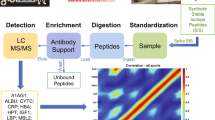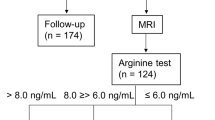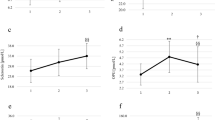Abstract
Athletes recognized the performance-enhancing potential of human growth hormone when it became available for treatment of short stature in growth-retarded children. Although no controlled clinical studies have demonstrated a significant benefit in highly trained adults with normal pituitary function, the practice of doping increased with the introduction of recombinant human growth hormone. Evidence of widespread abuse has been gathered by police and customs authorities or provided by former athletes. It has been difficult to develop a test to prove the administration of exogenous growth hormone in athletes because of its specific physiological and biochemical properties. Significant progress has only recently been made, particularly via two differing approaches. The 'marker approach' utilizes characteristic changes in concentrations of pharmacodynamic end points of growth hormone action, for example serum concentrations of insulin-like growth factor I and factors related to bone and soft tissue turnover. The 'isoform approach' detects changes in the molecular isoform composition of circulating growth hormone evoked by the administration of exogenous recombinant growth hormone. The isoform approach was applied at the Olympic Games in Athens in 2004 and in Turin in 2006. Used in a complementary way in an out-of-competition setting, these methods are a powerful tool with which to detect growth hormone abuse in sports.
Key Points
-
Detection of doping with growth hormone (GH) has been difficult because of the physicochemical identity between recombinant human GH (rhGH) and pituitary-derived GH, the short half-life and the pulsatile secretion pattern with highly variable concentrations in normal individuals
-
Two strategies have been developed: the 'marker approach' based on measurement of concentrations of GH-dependent parameters in serum, and the 'isoform approach' based on the detection of changes in the GH isoform spectrum after injection of recombinant GH
-
The marker approach works best with a combination of measurement of insulin-like growth factor I and amino-terminal extension peptide of type III procollagen; changes in the concentrations of these markers after GH administration exceed those seen under physiological conditions
-
The isoform approach utilizes specific immunoassays to detect the relative abundance of the 22 kDa isoform of GH compared with other GH isoforms; injection of rhGH leads, through negative feedback, to a suppression of isoforms other than 22 kDa GH
-
Both methods rely on immunoassays; therefore, the availability and maintenance of the specific antibodies involved is crucial
-
Widespread, out-of-competition use of the tests, probably in a complementary way, will enhance the chances of detecting cheating athletes
This is a preview of subscription content, access via your institution
Access options
Subscribe to this journal
Receive 12 print issues and online access
$209.00 per year
only $17.42 per issue
Buy this article
- Purchase on Springer Link
- Instant access to full article PDF
Prices may be subject to local taxes which are calculated during checkout


Similar content being viewed by others
References
Duchaine D (1983) Underground Steroid Handbook. Venice, CA: HLR Technical Books
Berggren A et al. (2005) Short-term administration of supraphysiological recombinant human growth hormone (GH) does not increase maximum endurance exercise capacity in healthy, active young men and women with normal GH-insulin-like growth factor I axes. J Clin Endocrinol Metab 90: 3268–3273
Rennie MJ (2003) Claims for the anabolic effects of growth hormone: a case of the emperor's new clothes? Br J Sports Med 37: 100–105
Ehrnborg C et al. (2005) Supraphysiological growth hormone: less fat, more extracellular fluid but uncertain effects on muscles in healthy, active young adults. Clin Endocrinol (Oxf) 62: 449–457
Rickert VI et al. (1992) Human growth hormone: a new substance of abuse among adolescents? Clin Pediatr (Phila) 31: 723–726
Wanjek B et al. (2007) Doping, drugs and drug abuse among adolescents in the state of Thuringia (Germany): prevalence, knowledge and attitudes. Int J Sports Med 28: 346–353
World Anti-Doping Agency: Prohibited List [www.wada-ama.org/en/prohibitedlist.ch2] (accessed 18 July 2007)
Abramson FP et al. (1996) Isotopic differences in human growth hormone preparations. Anal Chem 68: 1971–1972
Andersson C et al. (1996) Isolation and characterization of a trisulfide variant of recombinant human growth hormone formed during expression in Escherichia coli. Int J Pept Protein Res 47: 311–321
Hepner F et al. (2006) Mass spectrometrical analysis of recombinant human growth hormone norditropin reveals amino acid exchange at M14_V14 rhGH. Proteomics 6: 775–784
Lasne F and de Ceaurriz J (2000) Recombinant erythropoietin in urine. Nature 405: 635
De Frutos M et al. (2003) Differences in capillary electrophoresis profiles of urinary and recombinant erythropoietin. Electrophoresis 24: 678–680
Lasne F et al. (2002) Detection of isoelectric profiles of erythropoietin in urine: differentiation of natural and administered recombinant hormones. Anal Biochem 311: 119–126
Sasaki H et al. (1987) Carbohydrate structure of erythropoietin expressed in Chinese hamster ovary cells by a human erythropoietin cDNA. J Biol Chem 262: 12059–12076
Rice KG et al. (1992) Quantitative mapping of the N-linked sialyloligosaccharides of recombinant erythropoietin: combination of direct high-performance anion-exchange chromatography and 2-aminopyridine derivatization. Anal Biochem 206: 278–287
Lasne F (2003) Double-blotting: a solution to the problem of nonspecific binding of secondary antibodies in immunoblotting procedures. J Immunol Methods 276: 223–226
Van Cauter E et al. (1992) A quantitative estimation of growth hormone secretion in normal man: reproducibility and relation to sleep and time of day. J Clin Endocrinol Metab 74: 1441–1450
Hartman ML et al. (1991) Temporal structure of in vivo growth hormone secretory events in humans. Am J Physiol 260: E101–E110
Kanaley JA et al. (1999) Obesity attenuates the growth hormone response to exercise. J Clin Endocrinol Metab 84: 3156–3161
Richter SD et al. (1996) Time kinetics of the endocrine response to acute psychological stress. J Clin Endocrinol Metab 81: 1956–1960
Pritzlaff CJ et al. (1999) Impact of acute exercise intensity on pulsatile growth hormone release in men. J Appl Physiol 87: 498–504
Wideman L et al. (2002) Growth hormone release during acute and chronic aerobic and resistance exercise: recent findings. Sports Med 32: 987–1004
Eliakim A et al. (2001) Fitness, training, and the growth hormone-insulin-like growth factor I axis in prepubertal girls. J Clin Endocrinol Metab 86: 2797–2802
Kraemer WJ et al. (1999) Effects of heavy-resistance training on hormonal response patterns in younger vs. older men. J Appl Physiol 87: 982–992
Kraemer WJ and Ratamess NA (2005) Hormonal responses and adaptations to resistance exercise and training. Sports Med 35: 339–361
Ho KY et al. (1988) Fasting enhances growth hormone secretion and amplifies the complex rhythms of growth hormone secretion in man. J Clin Invest 81: 968–975
Anderson SM et al. (2001) Short-term estradiol supplementation augments growth hormone (GH) secretory responsiveness to dose-varying GH-releasing peptide infusions in healthy postmenopausal women. J Clin Endocrinol Metab 86: 551–560
Veldhuis JD et al. (2004) Short-term testosterone supplementation relieves growth hormone autonegative feedback in men. J Clin Endocrinol Metab 89: 1285–1290
Armanini D et al. (2002) Growth hormone and insulin-like growth factor I in a Sydney Olympic gold medallist. Br J Sports Med 36: 148–149
Parker ML et al. (1962) Studies on human growth hormone. II. The physiological disposition and metabolic fate of human growth hormone in man. J Clin Invest 41: 262–268
Holl RW et al. (1993) Diurnal variation in the elimination rate of human growth hormone (GH): the half-life of serum GH is prolonged in the evening, and affected by the source of the hormone, as well as by body size and serum estradiol. J Clin Endocrinol Metab 77: 216–220
Veldhuis JD et al. (2002) Impact of experimental blockade of peripheral growth hormone (GH) receptors on the kinetics of endogenous and exogenous GH removal in healthy women and men. J Clin Endocrinol Metab 87: 5737–5745
Ho KY et al. (1989) The pharmacokinetics, safety and endocrine effects of authentic biosynthetic human growth hormone in normal subjects. Clin Endocrinol (Oxf) 30: 335–345
Flanagan DE et al. (1997) Urinary growth hormone following exercise to assess growth hormone production in adults. Clin Endocrinol (Oxf) 46: 425–429
Leger J et al. (1995) The wide variation in urinary excretion of human growth hormone in normal growing and growth hormone-deficient children limits its clinical usefulness. Horm Res 44: 57–63
Albini CH et al. (1988) Quantitation of urinary growth hormone in children with normal and abnormal growth. Pediatr Res 23: 89–92
Saugy M et al. (1996) Detection of human growth hormone doping in urine: out of competition tests are necessary. J Chromatogr B Biomed Appl 687: 201–211
Saugy M et al. (2006) Human growth hormone doping in sport. Br J Sports Med 40 (Suppl 1): i35–i39
World Anti-Doping Agency: World Anti-Doping Code—International Standard for Laboratories Version 4.0 August 2004 [http://www.wada-ama.org/rtecontent/document/lab_aug_04.pdf] (accessed 18 July 2007)
Wallace JD et al. (1999) Responses of the growth hormone (GH) and insulin-like growth factor axis to exercise, GH administration, and GH withdrawal in trained adult males: a potential test for GH abuse in sport. J Clin Endocrinol Metab 84: 3591–3601
Le Roith D et al. (2001) The somatomedin hypothesis: 2001. Endocr Rev 22: 53–74
Wallace JD et al. (2000) Responses of markers of bone and collagen turnover to exercise, growth hormone (GH) administration, and GH withdrawal in trained adult males. J Clin Endocrinol Metab 85: 124–133
Burman P et al. (1997) Growth hormone (GH)-deficient men are more responsive to GH replacement therapy than women. J Clin Endocrinol Metab 82: 550–555
Dall R et al. (2000) The effect of four weeks of supraphysiological growth hormone administration on the insulin-like growth factor axis in women and men. GH-2000 Study Group. J Clin Endocrinol Metab 85: 4193–4200
Longobardi S et al. (2000) Growth hormone (GH) effects on bone and collagen turnover in healthy adults and its potential as a marker of GH abuse in sports: a double blind, placebo-controlled study. The GH-2000 Study Group. J Clin Endocrinol Metab 85: 1505–1512
Eliakim A et al. (1996) Physical fitness, endurance training, and the growth hormone-insulin-like growth factor I system in adolescent females. J Clin Endocrinol Metab 81: 3986–3992
Harrela M et al. (1996) Genetic and environmental components of interindividual variation in circulating levels of IGF-I, IGF-II, IGFBP-1, and IGFBP-3. J Clin Invest 98: 2612–2615
Juul A et al. (1995) Serum levels of insulin-like growth factor (IGF)-binding protein-3 (IGFBP-3) in healthy infants, children, and adolescents: the relation to IGF-I, IGF-II, IGFBP-1, IGFBP-2, age, sex, body mass index, and pubertal maturation. J Clin Endocrinol Metab 80: 2534–2542
Bang P et al. (1990) Exercise-induced changes in insulin-like growth factors and their low molecular weight binding protein in healthy subjects and patients with growth hormone deficiency. Eur J Clin Invest 20: 285–292
Hopkins NJ et al. (1994) Changes in circulating insulin-like growth factor-binding protein-1 (IGFBP-1) during prolonged exercise: effect of carbohydrate feeding. J Clin Endocrinol Metab 79: 1887–1890
Hornum M et al. (1997) Exercise-induced changes in circulating growth factors with cyclic variation in plasma estradiol in women. J Appl Physiol 82: 1946–1951
Schwarz AJ et al. (1996) Acute effect of brief low- and high-intensity exercise on circulating insulin-like growth factor (IGF) I, II, and IGF-binding protein-3 and its proteolysis in young healthy men. J Clin Endocrinol Metab 81: 3492–3497
Powrie JK et al. (2007) Detection of growth hormone abuse in sport. Growth Horm IGF Res 17: 220–226
Rigamonti AE et al. (2005) Growth hormone abuse: methods of detection. Trends Endocrinol Metab 16: 160–166
Healy ML et al. (2005) Toward the development of a test for growth hormone (GH) abuse: a study of extreme physiological ranges of GH-dependent markers in 813 elite athletes in the postcompetition setting. J Clin Endocrinol Metab 90: 641–649
Wright NM et al. (1995) Greater secretion of growth hormone in black than in white men: possible factor in greater bone mineral density—a clinical research center study. J Clin Endocrinol Metab 80: 2291–2297
Nelson AE et al. (2006) Influence of demographic factors and sport type on growth hormone-responsive markers in elite athletes. J Clin Endocrinol Metab 91: 4424–4432
Abellan R et al. (2006) Effect of physical fitness and endurance exercise on indirect biomarkers of recombinant growth hormone misuse: insulin-like growth factor I and procollagen type III peptide. Int J Sports Med 27: 976–983
Kurdy NM (2000) Serology of abnormal fracture healing: the role of PIIINP, PICP, and BsALP. J Orthop Trauma 14: 48–53
Baumann G (1999) Growth hormone heterogeneity in human pituitary and plasma. Horm Res 51 (Suppl 1): 2–6
Popii V and Baumann G (2004) Laboratory measurement of growth hormone. Clin Chim Acta 350: 1–16
Nakamoto JM et al. (1986) Suppression of the growth hormone (GH) response to clonidine and GH-releasing hormone by exogenous GH. J Clin Endocrinol Metab 62: 822–826
Leung KC et al. (2002) Physiological and pharmacological regulation of 20-kDa growth hormone. Am J Physiol Endocrinol Metab 283: E836–E843
Wu Z et al. (1999) Detection of doping with human growth hormone. Lancet 353: 895
Bidlingmaier M et al. (2000) Test method: GH. Baillieres Best Pract Res Clin Endocrinol Metab 14: 99–109
Wu Z et al. (2002) Development of human growth hormone (hGH) isoform specific antibodies and their use in a possible test to detect hGH-doping in sports. Abstract P3-527 presented at the 84th Meeting of the Endocrine Society: 2002 June 19–22, San Francisco, CA
Hashimoto Y et al. (2000) Exogenous 20K growth hormone (GH) suppresses endogenous 22K GH secretion in normal men. J Clin Endocrinol Metab 85: 601–606
Ishikawa M et al. (1999) Serum levels of 20-kilodalton human growth hormone (GH) are parallel those of 22-kilodalton human GH in normal and short children. J Clin Endocrinol Metab 84: 98–104
Wallace JD et al. (2001) Changes in non-22-kilodalton (kDa) isoforms of growth hormone (GH) after administration of 22-kDa recombinant human GH in trained adult males. J Clin Endocrinol Metab 86: 1731–1737
Wallace JD et al. (2001) The response of molecular isoforms of growth hormone to acute exercise in trained adult males. J Clin Endocrinol Metab 86: 200–206
Keller A et al. (2007) Pharmacokinetics and pharmacodynamics of GH: dependence on route and dosage of administration. Eur J Endocrinol 156: 647–65355
Author information
Authors and Affiliations
Corresponding author
Ethics declarations
Competing interests
Martin Bidlingmaier received research grants from the World Anti-Doping Agency (WADA) and holds stock in the CMZ-Assay GmbH, Berlin, Germany, which is involved in the production of assay kits to measure growth hormone. Christian J Strasburger is recipient of research grants from the World Anti-Doping Agency (WADA) and formerly from the International Olympic Committee (IOC) and holds stock in the CMZ-Assay GmbH, Berlin, Germany, which is involved in the production of assay kits to measure growth hormone.
Rights and permissions
About this article
Cite this article
Bidlingmaier, M., Strasburger, C. Technology Insight: detecting growth hormone abuse in athletes. Nat Rev Endocrinol 3, 769–777 (2007). https://doi.org/10.1038/ncpendmet0644
Received:
Accepted:
Issue Date:
DOI: https://doi.org/10.1038/ncpendmet0644



